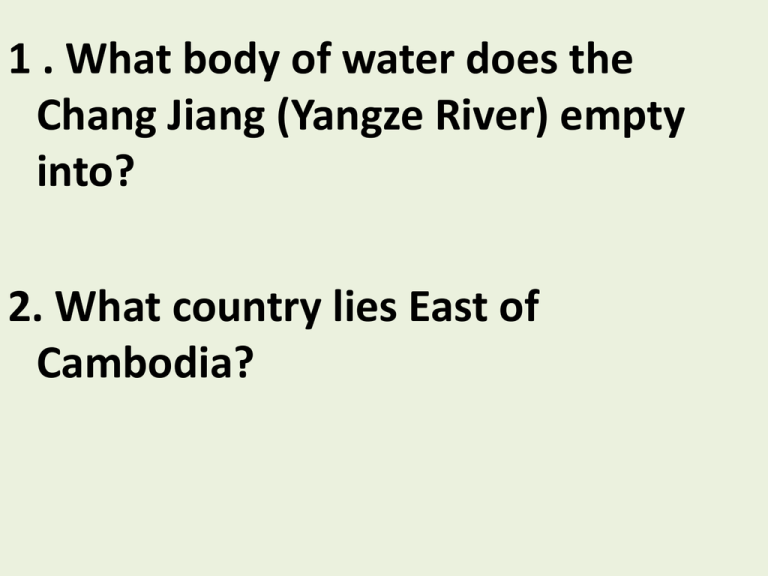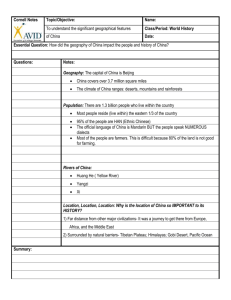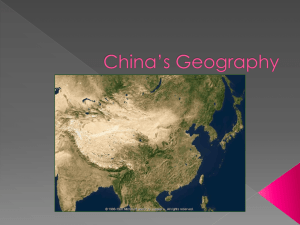Asian Geography
advertisement

1 . What body of water does the Chang Jiang (Yangze River) empty into? 2. What country lies East of Cambodia? Landscape of East Asia among the roughest in the world…yet is one of the most populated place in the world!!!! – Mountains and deserts restrict movement of people, goods, and ideas. So how does this affect their culture????? Where would you want to live? Brahmaputra Ganges Huang He (Yellow) Mekong India Indus Ganges 1.Ganges - 1557 miles long, flows through India and Bangladesh, from the Himalayas eastward and empties into the Bay of Bengal, considered holy to the Hindus of India, very polluted 2.Indus – 1975 miles long, flows through China, Pakistan, and India. Begins in Tibet and flows into the Arabian Sea. 1.Brahmaputra – (brah-muh-poo-truh)1800 miles long, China to Bangladesh, joins the Ganges and empties into the Bay of Bengal, often floods 2.Huang He (Yellow River) – “China’s Sorrow”, 3395 miles long, name comes from the yellow silt that is deposited along its banks. 3.Chang Jiang (Yangtze)- 3917 miles long, China’s longest river, empties into the East China Sea Huang He (Yellow Brahmaputra China Chang Jiang(Yangtze Southeast Asia 1. Mekong (mey-kong)– 2635 miles long, forms the border between Laos and Myanmar (Burma) and most of the border between Laos and Thailand, empties into the South China Sea Plateau of Tibet Himalayas • The Himalaya is the world's largest mountain range. Its peak is 26, 000 feet high. • Stretch 1,700 miles across • Passes through five nations: India, Pakistan, China, Bhutan and Nepal. • Mount Everest, the highest mountain in the world, is part of the Himalayas in Nepal. • The first people to climb Mount Everest was in 1953. • The origin or source of world's two important river systems: the Indus Basin and the GangaBrahmaputra Basin. Gobi Desert • It covers 500,000 square miles, twice the size of Texas • Extends 1,000 miles from east to west, 600 miles north to south. • Name is Mongolian for "the waterless place“ • Rainfall is often less than three inches a year. • The Gobi's aridness is caused by the rainblocking effects of the Altai mountains to the west and Tibetan plateau and the Himalayas some distance away to the south. The Gobi itself lies on a plateau. • Large deposits of copper and gold Taklimakan Desert • Nicknamed “Sea of Death” • Poisonous snakes, frequent sand storms, boiling days, freezing nights, and intense water shortages. • Second largest desert in the world. • Mummies, some 4000 years old, have been found in the region Plateau of Tibet • Highest region on Earth • Commonly referred to as the “Roof of the World” • Highest and largest plateau on the planet • Lies between the Kunlun (koon-loon) Mountain ranges to the north and the Himalayas to the south • Several of the world's longest rivers have their sources on the Tibetan Plateau • • • • • Khyber Pass Connects Pakistan & Afghanistan 33 miles long through Hindu Kush mtns There have been many battles for its control Best land route between India and Pakistan Conquering armies have used the Khyber as an entry point for their invasions • Has been a major trade route for centuries New Delhi Tokyo Beijing India’s Capital – New Delhi • Constructed 1912-1929 to replace Calcutta as the capital of British India and officially inaugurated in 1931. • Trade & transportation center • Population: 317,797 • Chronic overcrowding, traffic congestion, ballooning child labor, housing shortages and pollution. • One of the fastest growing cities in the world. • Hinduism is the religion of 86.8% of New Delhi's population Street scene. Residence of the President of India Taj Mahal Cows rest in a crowded street China’s Capital – Beijing (Peking) • • • • • • • 2nd largest city in the country The Great Wall of China. population of 17.55 million people political, educational and cultural center of the country Many historical sites are located here. Beijing hosted the 2008 Summer Olympic Games. You are not permitted to drive a car unless you have a driver license issued by China. Driving in Beijing can be quite complicated due to perpetual traffic jams. Shopping Area Beijing National Stadium AKA Birds Nest Stadium Forbidden City • • • • • • • • • Population: 12 million Country’s largest city-one of the most crowded and expensive cities in the world Prior to 1868, Tokyo was known as Edo. September 1923 – the Great Kantō Earthquake devastated Tokyo. More than 142,000 people died and over 300, 000 houses were destroyed. Tokyo Disneyland was opened in 1983 as the first Disney theme park outside of the United States. Tokyo Disney Sea is a fantasy theme park in Tokyo Disney that is unique to Japan Over 150 colleges/universities 1964-Tokyo held the summer Olympic games. Bombing during World War II devastated half of Tokyo, destroyed or damaged many famous landmarks, and ruined nearly all of the city's industries Japan’s Capital - Tokyo Tokyo Disney Sea Imperial Palace Bullet train Shinjuku Avenue , Business District Environmental Issues Monsoons Polluted Rivers Asian Brown Cloud-air pollution Overpopulation








